Knife Skills: Different Types of Cuts
 Updated February 22nd, 2015
Updated February 22nd, 2015Different Types of Knife Cuts
There are many different types of cuts and while you may not use all of them, it's important that you know and understand them. Having the knife skills and know-how to cut a brunoise, matchstick, or batonnet will not only help you improve your knife skills, but also improve the visual appeal and professionalism of the food you cook.
If you're like most people, you will likely chop your items as fast as possible without knowing or understanding why it's important to cut properly. The first reason is uniformity. Take a carrot, for instance. It goes from very fat to very thin and most people will use a coin cut to slice it. This leaves very large and very small pieces in relation to itself. Why is this important? Well, large pieces take longer to cook (Especially when it comes to carrots). Uniformity in cutting ensures that you have even, predictable cooking times. Nobody wants carrots that are mushy and hard at the same time!
The second reason is aesthetics. Properly cut items look professional and have that visual appeal. Much of your appetite and the appetite of others stems from the visual appeal of your dish. The presentation is of the utmost important and a large percent of the satisfaction that people get from food comes from their eyes. People eat with their eyes, and it's important to never forget that!
Top Professional Chef Knives
Wusthof Classic 8" Chef Knife
Global G-2 Chef Knife 8"

Shun Chef Knife 8"

The Basic Types of Cuts
Taking into account that much of the reasoning behind the different cuts tie into the ability to cook accurately first, and aesthetically second is a foundational skill. Keeping these in mind will help you determine what type of cut is appropriate for the dish you are cooking and help you become a better cook. Obviously a diced carrot takes longer to cook than an equally sized dice of, say, celery. Using your knowledge, you will know that you will have to precook the carrots first before adding the celery!
Once you get into the routine of making your own stocks you will learn that much of the waste will be transformed into delicious stocks.
Squaring Off Your Items
Before cutting an item, we're going to learn how to square off the item you're about to cook. The idea is to get the item to a stage that allows your cuts to be done uniformly. We will use the carrot as an example, as it is the most common abnormally shaped item you will be using. A lot of the skills you will learn will leave you with a bunch of waste. This is not as bad as you think! Once you get into the routine of making your own stocks you will learn that much of the waste will be transformed into delicious stocks. These techniques put form and perfection first. Many chefs and cooks will tell you this method produces TOO much waste. While it is true, remember that cutting and chopping has its own "Pick two of three" catch 22. This is:
Speed, Waste, Uniformity
If you want speed and low waste, you'll lose uniformity.
If you want low waste and uniformity, you'll lose speed.
If you want speed and uniformity, you'll have more waste.
If you want low waste and uniformity, you'll lose speed.
If you want speed and uniformity, you'll have more waste.
Understanding these conditions, you will come to settle on a spot that is comfortable to you. Many industry professionals will settle somewhere in the middle.Let's get started on squaring off your carrot:
Start by peeling the carrot, removing the ends. Then, slice the carrot into segmented lengths of 4cm (2in.). Taking one of the segments, you will slice one end to produce a flat surface. This surface will then be laid flat, and you will continue the process for remaining sides. Your carrot segment will come out looking like a 3-dimensional rectangle. Now that you've squared off your carrot, you're ready to start producing the type of cut you're after.
The Julienne Cut
The julienne is a type of cut that is stick-shaped and very thin. Cut from a squared off item, you will then slice that item length-wise at a thickness of 1-2mm (1/16 in) leaving you with thin rectangular cuts. Then, take the thin slices and apply the same technique. You will end up with Julienne (Or matchstick) cuts!
Dimensions: 2mm X 2mm X 4cm (1/16in X 1/16in X 2in)
Dimensions: 2mm X 2mm X 4cm (1/16in X 1/16in X 2in)
The Brunoise Dice
The Brunoise dice is the smallest dice you can have. While you can mince to a smaller dimension, this method refers to the smallest uniform size available for dicing. This method is simple and only adds an additional step to the Julienne method. Take your julienne cuts and bunch them up with your hand. Then cut the julienne into equally shaped dice. That's it! While simple, it does take a long time to master. Get crackin'! Great for Soups
Dimensions: 2mm X 2mm X 2mm (1/16 in X 1/16 in X 1/16 in)
Dimensions: 2mm X 2mm X 2mm (1/16 in X 1/16 in X 1/16 in)
The Small Dice
The small dice are similar to the brunoise, but it is slightly larger. Start by following the steps to Julienne your item. You want to slice your squared-off item at a thickness of 3mm. Now it's only a matter of finishing off the dice as you would the Brunoise!
Dimensions: 3mm X 3mm X 3mm (1/8 in X 1/8 in X 1/8 in)
Dimensions: 3mm X 3mm X 3mm (1/8 in X 1/8 in X 1/8 in)
The Batonnet
You're probably starting to notice a pattern here. We start with squaring off our item, slicing it to the thickness desires, and then going from there. The batonnet is no different, but what the purpose of knowing these cuts are they are standard sizes that you'll see in most professional recipes as well as recipes posted on TheCulinaryCook. Let's continue. The Batonnet is no different, and we are aiming for a larger stick-cut. The batonnet is used when serving a larger potion of an item such as a vegetable side, to gain height in your dish, or to provide imposing linear appeal to an otherwise linear-absent dish.
Dimensions: 6mm X 6mm X 6cm (1/4 in X 1/4 in X 2 in)
Dimensions: 6mm X 6mm X 6cm (1/4 in X 1/4 in X 2 in)
The Medium Dice
The medium dice type of cuts are derived from the Batonnet and the only added step is slicing the batonnet to produce cubes. This size is called a Medium Dice.
Dimensions: 6mm X 6mm X 6mm (1/4 in X 1/4 in X 1/4 in)
Dimensions: 6mm X 6mm X 6mm (1/4 in X 1/4 in X 1/4 in)
The Baton
The baton type of cuts are the largest stick-cut you can cut. It is used for crudites and for presentation purposes. While not used as much as the rest, it is the foundation for the more common Large Dice.
Dimensions: 12mm X 12mm X 6cm (1/2 in X 1/2 in X 2-1/2 in)
Dimensions: 12mm X 12mm X 6cm (1/2 in X 1/2 in X 2-1/2 in)
The Large Dice
The large dice types of cuts are primarily used for stews, long-cooking dishes and for mirepoix in stocks. The large dice is important, because it is relatively quick, has a great imposing nature and looks professional. When cutting a large dice, you will tend to have a higher waste when trying to get nicely cut pieces using the method describing how to square off your item. Remember when doing any cutting or dicing to use the method best suited for your dish.
Dimensions: 12mm X 12mm X 12mm (1/2 in X 1/2 in X 1/2 in).
Dimensions: 12mm X 12mm X 12mm (1/2 in X 1/2 in X 1/2 in).
The Paysanne Cut
The paysanne types of cuts are included here to show you that while cubed items are common, sometimes you would prefer a slimmer, flat, square item. This is called the Paysanne. This is achieved by creating your desired stick-cut size, then slicing thinly to produce a thin square. Typically used for larger cuts, this method can be applied to smaller cuts and dices as well.
Dimensions: 12mm X 12mm X 3mm (1/2 in X 1/2 in X 1/8 in)
Dimensions: 12mm X 12mm X 3mm (1/2 in X 1/2 in X 1/8 in)
There are different types of cuts that you can use as well.
The Chiffonade
The chiffonade types of cuts are used when slicing very thin items such as herbs or leaf vegetables such as spinach. Cutting en chiffonade is a really simple process. Start by stacking the items you are looking to slice. Then roll up the items, producing a cigar-shaped roll. Once it's rolled, start slicing to produce a nice chiffonade suitable for garnishing and other purposes.
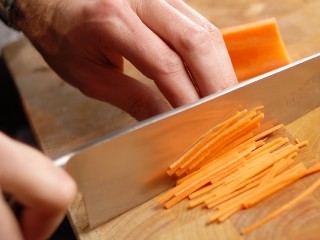

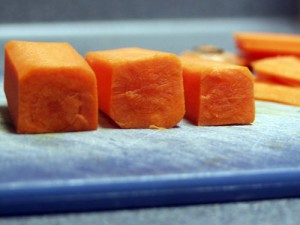
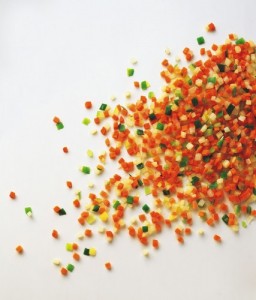

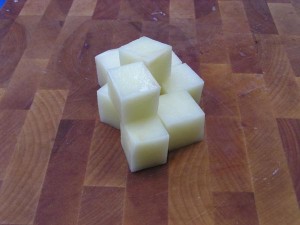

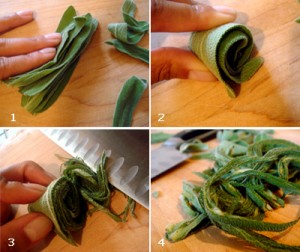
No comments:
Post a Comment